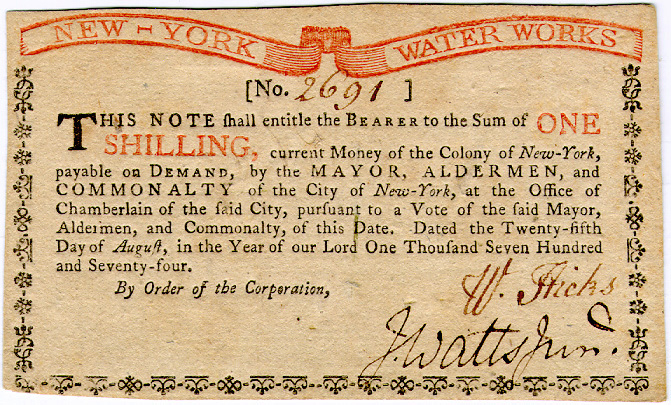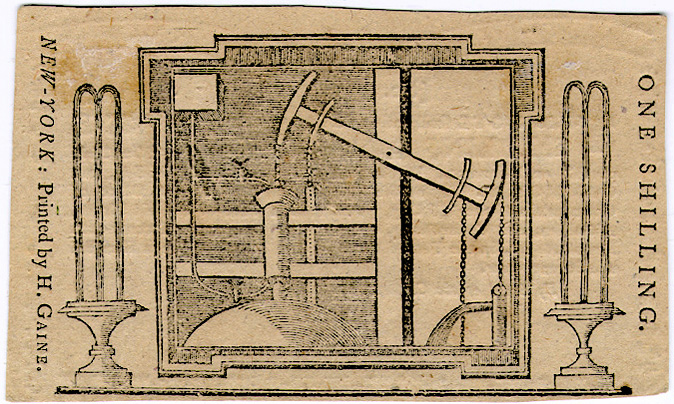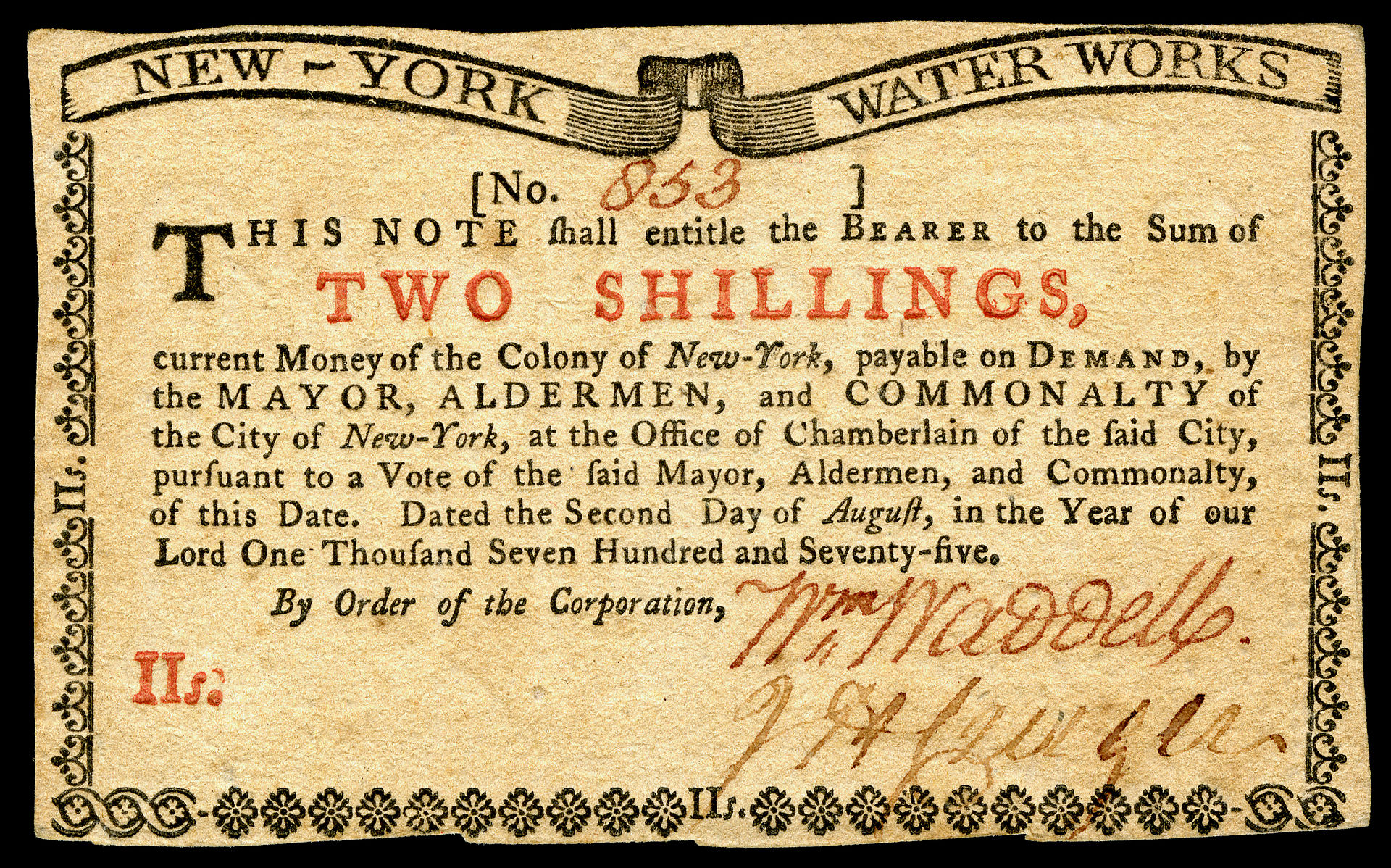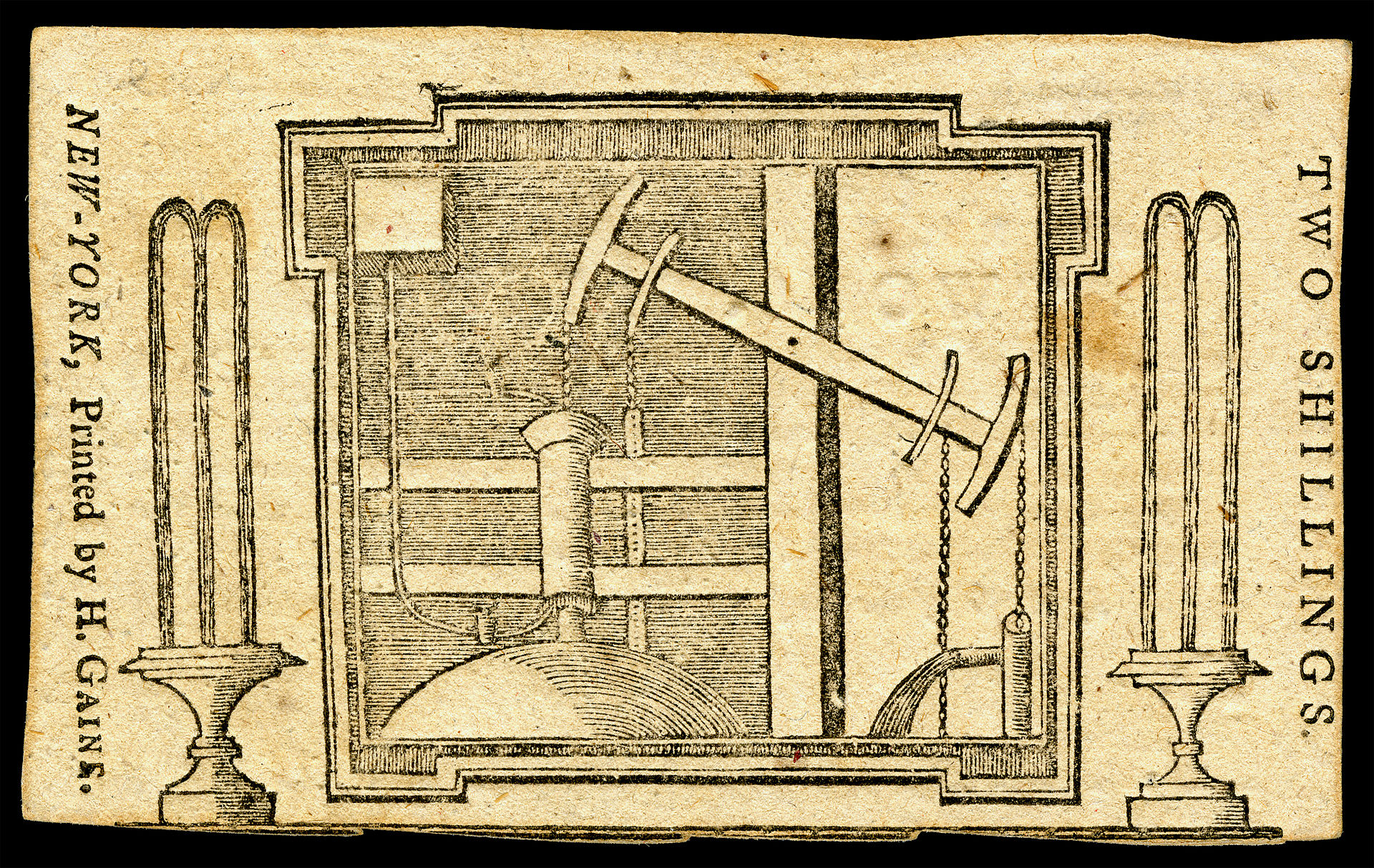



| Introduction | Historical Background | Chronology | Geography | Biography | Technology | Ownership and Financing | General Bibliography |
| Middle Atlantic States | New York | New York City | Christopher Colles |
Christopher Colles offered a proposal to the New York Common Council in August, 1774, to build a water works on Manhattan Island that would include a reservoir holding 1.2 million gallons of water, a Newcomen-type steam engine that could pump 200,000 gallons of water daily into the reservoir, and wooden pipes installed in every main street, all for a cost of Eighteen Thousand Pounds New York currency. The Common Council accepted the proposal, becoming the first municipally-owned water works in America.
Colles had a steam engine constructed locally and the city purchased 60,000 feet of logs from Isaac Man and Isaac Man, Jr. in Albany County. The engine was tested but it is unclear if any pipes were installed. The entire project was halted by the British invasion of New York in July, 1776. The engine and reservoir were destroyed and several years after the war Colles recovered funds he was owed.
This was one of the earliest steam engines in North America and represented an enormous advance in technology, even though it was ultimately unsuccessful through no fault of Colles.
The project was funded in part by issuing 5% bonds called Water Works Money, which had a rendering of the proposed engine on the reverse side:
 |
 |
 |
 |
References
1774 Proposal of Christopher Colles, For
furnishing the City of New-York with a constant Supply of Fresh
Water.
1774 Minutes of the Common Council of the City
of New York, 1675-1776, Volume 8 By New York (N.Y.).
Common Council Several references to Colles, including:
Pages 26-27: April 22, 1774. The Proposal of Christopher
Colles to Erect a Reservoir, and to Convey Water thro' the Several Streets
of this City was preferred to this Board & Read; and thereupon order'd
that the same be filed, and that the Consideration thereof be deferred to
Some future Time.
Pages 40-41: July 21, 1774. The Proposal of Christopher Colles
heretofore prefered to this Board, Respecting the Building of a Reservoir
and the Conveyance of Fresh Water thro' the several Streets, Lanes and
Alleys of this City and the Expence that will attend to said Undertaking,
being this Day taken into Consideration, it was moved that the same be
Carried into Execution, but Debates arising thereon, the Question was put
whether this Board shall carry the same Proposal into Execution, which was
carried in the manner following, to wit, [list of 7 affirmative and 2
negatives votes]
Page 138: May 24, 1776. Ordered the like to Christopher Colles
or order the Sum of 6 for his Attendance in taking Care of the Water Works
for one month due to him the 19th Day of May inst.
1915-1928. The
Iconography of Manhattan Island, 1498-1909: Compiled From Original
Sources and Illustrated by Photo-Intaglio Reproductions of Important
Maps, Plans, Views, and Documents in Public and Private Collections
by Isaac Newton Phelps, 6 Volumes.
4:856
June 11, 1774. Gerard Bancker, city surveyor, computes "the
length of all the Streets in the City of New York thro which
Mr. Colles proposed to lead the Water from his Works" as about 14 miles.
The original report, undated, is among the
miscellaneous papers in the city clerk's record-room and is reproduced as
Pl-39,
Vol. IV.
1774 Rivington's New
York Gazetteer, July 24, 1774, Page 3.
Last Thursday the Corporation of this city met and agreed to Mr.
Christopher Colles's proposal, for supplying this city with fresh water by
means of a Steam Engine Reservoir, and conduit pipes; and in order to
carry the said useful and laudable design into immediate execution; they
resolved to issue promissary notes as the work shall advance.
According to the design, the water will be conveyed through every street
and lane in the city, with perpendicular conduit pipe at every hundred
yards, at which water may be drawn at any time of the day or night, and in
case of fire each conduit pipe will be so contrived as to communicate with
the extinguishing fire-engines, whereby a speedy and plentiful supply of
water may be had in that calamitous situation. .
1774 Water Works Promissory Note, August 25, 1774.
1774 New-York
Gazette, and Weekly Mercury, September 5, 1774, Page 2.
New-York Water Works. Notice is hereby given, that a large quantity of
pitch pine logs will be wanting for the New-York water works; Such persons
as are willing to engage to furnish the same, are desired to send their
proposals, in writing, before the 20th of October next, to Christopher
Colles, contractor for said works.
These logs must be of good pitch pine, streight and free from large knots,
and 20 feet long; one fourth of the number of logs to be of 12 inches
diameter, exclusive of sap at the small end; and the remaining three
fourths of 9 inches diameter, exclusive of sap, at the small end.
1774 Minutes
of the Common Council of the City of New York, November 8,
1774, 8:62-63.
This Board having contracted with Isaac Man & Isaac Man Junr of the
County of Albany for 60,000 feet of pitch Pine Timber, for the making of
Pipes of the Water Works, to be delivered as follows, to wit a third part
to be delivered on the first Day of July 1775, another third part on the
first Day of August, and the remaining third part on the first Day of
August, for which Sum they are to received 1250, and Articles of Agreement
being drawn, and produced to this Board were approved of, and signed by
Mr. Mayor, the Seal of the Corporation being affixed thereto, and ordered
to be delivered to the same Isaac Man & Isaac Man, Junr on their
executing a Counterpart thereof, and giving sufficient security for the
Performance of the same.
1775 Rivington's
New-York Gazetteer, February 16, 1775, Page 3.
New York, February 9. On Friday last, at Messieurs Sharp and Curtenius's
Furnace, in this city, a Cylinder was cast for the steam engine of the
Water Works, now carrying on here; being the first performance of the kind
ever attempted in America, and allowed by Judges to be extremely well
executed.
1776 New-York Gazette,
and Weekly Mercury, March 4, 1776, Page 3.
To the Inhabitants of the City of New-York. The Fire Engine of the
Water Works being now completely finished, Mr. Colles proposes to keep it
going for several Days successively, to give every Gentleman an
Opportunity of seeing it; and in order that they may more easily know when
it is a working, a Flag will be display'd in the Middle of the Road, which
may be seen from any Part of the Broadway.
1776 New-York
Gazette, and Weekly Mercury, March 11, 1776, Page 3.
We can with Pleasure assure the Public, that the Fire Engine of the Water
Works was work'd many Days last Week, greatly to the Satisfacton of vast
Numbers of People who went to see it. This Engine carries a Pump of
11 inches diameter, and 6 Feet Stroke, which contains 29 Galls.
Makes 10 Strokes in a
Minute,
290
In one hour, 174 Hogsheads,
17400
In 12 Hours, 2088
ditto,
208800
In 24 Hours, 4176
ditto,
417600
The Well is 30 Feet diameter, and 30 deep, contains 8 Feet depth of Water.
The Water is inexhaustible, for the Pump, tho' continually work'd, cannot
lower the Water more than two Feet.
1776 Journal of Lieutenant Isaac Bangs, April 1
to July 29, 1776, by Isaac Bangs. Edited by Edward Bangs.
(1890) Excerpts from Bangs' Journal were read before the New England
Historic Genealogical Society on May 2, 1855 by Dean Dudley and printed in
the Boston Daily Bee in February 1856. They were reprinted in the
1868 "New York in 1776," The
Historical Magazine and Notes and Queries Concerning the Antiquities,
History and Biography of America, 4:305.
Page 25-27: [April 20, 1776] I visited, and took a full view of the
Waterworks that are making to convey Water through the City (that from the
Pumps being very bad & unwholesome to that degree that the Inhabitants
buy Water for Coffee, &c. from Carts that are employed to carry it
about the City). These Works were began about 12 Months since at the City
Expence, to defray which they issued Bills that are current as other
Money. A Dutchman undertook the Jobb for a certain sum, & hath already
performed the most difficult part of the Work, tho not with that success
that was expected by the Citizens, as they say. He saith he hath done as
well as he promised. The Work that is already done (the most difficult
part) is to convey Water from the side of an Hill nigh a Pond to the top
of the Hill, which being higher than any part of the City, the Water is to
be conveyed in Pipes through the City. As the Man that attended spoke very
broken English & the Machiene was not at Work, it was with great
Difficulty that I understood the Construction of the Machiene ; & to
pretend to give a particular description of this Work would be folly in
me, as I could by no means do it Justice. The first part of the Work was
the Well, about 40 feet Diameter, and to appearance about 30 feet to the
surface of the Water. In this Well was the Engine, which forced the Water
almost to the Top, & from thence through a Wooden Tube up to the Top
of the Hill, which was about 5 Rods distance and about . . . Feet
perpendicular above the Top of the Well. At the Top of the Hill was an
artificial Pound, whose superficies was about | of an Acre, and when
filled, the Water would be about 8 or 10 Feet deep ; from hence the Water
was to be conveyed (as I before said) in Pipes through the City. All of
this I could easily understand ; but the grand Question was how was the
Machiene in the Well first actuated & continued its motion? This I was
surprised to find was wholly done by the Power of Boiling Water.
It was a long time before I could discover even by seeing the Works how
this could be effected, & the Man who shewed the Works could give me
no satisfaction as to this till at length I found that by Means of a large
Copper (which is kept boiling when it is requisite for the Works to be set
in Motion) the Steem or Vapour of the Water is conveyed from thence into a
strong Copper Tube of about 18 Indies Diamiter & about 10 Feet Long,
which stands perpendicularly. The lower part or end of this Tube is tight;
but the iiper End hath in it a moveable Stopper which may move upwards or
Downwards with as much ease as possible, and at the same time to keep any
of the Air from without from entering into the Tube & to keep it as
tight as possible another part of the Works constantly supply the Top of
the Tube above the Stopper with a small stream of Water. The Steem of the
Hot Water (as I take it) entering into the Tube rarifyeth the Body of the
Air contained therein to a great degree, when the Stopper is let loose and
flyeth upwards
with great Rapidity to the upper End of the Tube, when the Pressure of the
Air from without throweth [it] back to the Bottom of the Tube with as
great Force as it came upwards. When it gets to the Bottom it is
again drove upwards by the same cause, c% repelled when it arrives at the
Top : thus the Stopper is kept in constant Motion by the Means of Steam or
Vapour, & to this Stopper is fastened a stout Wooden lever by a bar of
Iron. The Lever is Fastened in the Middle upon an Axis ; and as the
Stopper of the Tube moves upwards and downwards, it moves the Lever, which
worketh the Engine in the Well, which forceth (as I before described) the
Water into the Pond at the Top of the Hill. The Engine hath been tried
& generally throws . . . Gallons in a Minute into the Pond. Thus have
I given as perticular discription of this curious Engine as I possibly
could, having viewed it but about 15 Minutes. I hope soon to see it at
Work, when I can give a more perticular discription of several small parts
of it for which I could see no use.
1776 A
tour through part of the north provinces of America: being, a series
of letters wrote on the spot, in the years 1774, & 1775,
by Patrick M'Robert.
Page 4: Their tea water they get at present brought in carts thro'
the streets from the suburbs of the city; but they are now erecting a fire
engine for raising the spring into a reservoir, from whence, by pipes,
they can convey it to any part of the city.*
*The pump water was brackish, and drinking or tea water had to be procured
in the suburbs from the "Tea Water Pump." The English engineer,
Christopher Colles, persuaded the Common Council to construct a municipal
water system. A reservoir of 20,000 hogsheads capacity served by a steam
pump was built between Pearl and White Streets. It was covered to keep off
the sun's rays which were believed to contaminate the water. The cylinder
for the engine was cast in a local iron works. Fourteen miles of hollow
log conduits were planned, and ordered from Albany, but the outbreak of
hostilities prevented the completion of the scheme. Mia. Com. Council,
VIII. 26ff.; Edwards, op. cit., 139-141; New York Weekly Mercury, Aug. 1,
1774.
1776 Minutes of the Common Council of the City
of New York, 1675-1776, Volume 8
Page 138: May 24, 1776. Ordered the like to Christopher Colles
or order the Sum of 6 for his Attendance in taking Care of the Water Works
for one month due to him the 19th Day of May inst.
1788 "Water-Works," The
New-York Packet, January 29, 1788, Page 3.
The following Petition is now handing around this city in order to take
the sense of the inhabitants whether they would wish the city should be
furnished with a plentiful supply of water, by means of water works and
conduit-pipes, as proposed (and party executed) before the later war.
To the Hon. the Mayor, Aldermen and Commonalty of the City of New-York in
Common Council convened:
:That as the present mode of furnishing this City and shipping with water,
is in many respects subject to many inconveniences, we do hereby declare
our approbation of a design for supplying the same by means of waterworks
and conduit pipes, and will (as soon as the same shall be compleated) be
satisfied to pay our respective proportion of a tax for the purpose,
provided the same does not exceed twenty-six shillings for each home per
annum, at an average.
May it therefore please your honors to take the premises into
consideration, and to adopt such measures for effecting the same as you
shall judge most expedient, for the advantage, convenience and safety of
the City.
| C A L C U L A T I O N | |
| Supposing
3200 houses in the city at 26s is Of which 1000 houses rated at 45s per ann. 1000 ditto 26 1200 ditto 10/2d |
£4160 2250 1300 610 £4160 |
1784-1831 Minutes of the Common Council of the City of New York, 1784-1831, Volume 1
1789 A survey of the roads of the United States of America, by Christopher Colles | also here | 1961 reprint |
1844 "The First Water Works" from Reminiscences of the City of New York and Its Vicinity [by Henry B. Dawson and William J. Davis]
1854 Manual
of the Corporation of the City of New York, for the Year 1854.
Pages 215-223: Water Chronology of the City of New York
1860 History of the city of New York: From its earliest settlement to the present time by Mary Louise Booth
1896 The Water Supply of the City of New York,
1658-1895 by Edward Wegmann
Page 4: As early as 1774, when New York had a population of only 22,000,
Christopher Colles,* an English civil engineer, made to the Common Council
a proposal for constructing waterworks. His proposition was to construct a
large reservoir on Manhattan Island, into which water was to be pumped
from wells by means of a steam-engine, and to distribute the water from
the reservoir by pipes laid in the principal streets.
The Common Council accepted Mr. Colles' proposal in July 1774, and on the
8th of August passed the following resolution:
''Ordered, That the northerly part of the property of Augustus Van
Cortlandt and Frederick Van Cortlandt, fronting on Great George Street,
[now Broadway) be purchased at £600 per acre, for a reservoir, provided,
that on sinking a well there, good water be found. If not, the well to be
filled up by the Corporation."
The quality of the water proving satisfactory, i£ acres of land were
bought of the Van Cortlandts for grow, the deeds being signed on October
8, 1774. A spacious reservoir was constructed on this property on the east
side of Broadway between the present Pearl and White streets. A large well
was sunk near the "Collect," a fresh-water lake fifty feet deep.
Additional wells were dug subsequently and some water was pumped directly
from the "Collect."
To defray the expenses of the work and to pay for the land purchased,
bonds bearing 5% interest and paper bills, denominated Water Works Money,
were issued to the amount of .£11,400. From the fac-simile of one of these
paper notes, given on page 5, some idea can be formed of the kind of
machinery which Mr. Colles intended to employ for the pumping. The engine
shown on the back of the note represented undoubtedly one of Newcomen's
Atmospheric Engines, a machine that had been largely used in Europe, from
the beginning of the century, for pumping water from mines. One of these
engines had been imported in 1760 by the owners of the old copper mines
near Belleville, New Jersey. In 1776 the works were put in
operation, Mr. Colles being made the Superintendent. The water was
distributed through hollow logs, laid in the principal streets. Owing,
however, to the insufficient supply furnished, and the confusion caused by
the Revolution, the whole enterprise was soon abandoned.
* Christopher Colles, an accomplished civil engineer, linguist, and man of
science, was born in Ireland of English parentage in 1738. He came to
America in 1765; lectured on canal navigation in 1772, published a series
of sectional road maps, assisted almanac-makers in their calculations, and
engaged in manufacturing printer's colors and paper boxes. Although highly
esteemed by men of science and at one time Actuary of the Academy of Fine
Arts, he died in comparative obscurity in New York in 1821.
1917 "Christopher Colles' Water Works" from The Catskill Aqueduct and Earlier Water Supplies of the City of New York: With Elementary Chapters on the Source and Uses of Water and the Building of Aqueducts, and an Outline for an Allegorical Pageant by New York Mayor's Catskill Aqueduct Celebration Committee
1917 "City
Water System Proposed in 1774," The New York Times, August
26, 1917, Page 36. | Also here
|
Christopher Colles Pioneer in Long Series of Efforts to Supply New York.
REVOLUTION STOPPED WORK. Sum of £6,500 Was Authorized and £3,600 Expended
on Reservoir, Well, and Pump.
1917 "Water Works History" from Twenty Second Annual Report of the American Scenic and Historic Preservation Society 1917
1917 New York as an Eighteenth Century Municipality, 1731-1776, by George William Edwards
1923 "The
First Attempt to Introduce Running Water into the Houses of New York,"
from Valentine's
Manual of Old New York 1924, edited by Henry Collins Brown.
1774.—The proposal of Christopher Colles, heretofore preferred to this
Board respecting the building of a Reservoir and the conveyance of fresh
water through the city, being under consideration, it was resolved that it
be carried into execution.
Messrs. Augustus and Frederick Van Cortland offered to convey to the
Corporation sufficient ground, fronting Great Gorge Street, (now Broadway,
above Chambers Street,) as might be necessary for the Reservoir, at the
rate of £600 per acre, which being thought reasonable, it was resolved to
purchase the same, provided that upon sinking a well there, the water
should be found of good quality.
Having subsequently tried the experiment of digging a well, and judging
the water to be of a very good quality, the Corporation resolved to carry
out the plan, and to issue notes to the amount of £2,500, to be drawn up
in the following sums, 4,000 of sixpense, (£100,) 4,000 of one shilling
each, (£200,) 4,000 of two shillings (£400,) 4,000 of four shilling,
(£800,) and 2,500 of eight shillings, (£1,000;) and Mr. Colles was
directed to enlarge the well and go on with the work.
The Board soon after entered into a contract with parties at Albany for
60,000 feet of pitch-pine timber, for the making of pipes for the water
works, for the sum of £1,250. The land purchased for the purpose, (about
two acres,) was paid for. The sum of £1,000 was advanced to Colles in
1774, and in 1775 £600. In January, 1776, the Board allowed Mr. Colles £10
per month toward his support.
In March, 1776, new notes, to the amount of £2,000, were issued toward
defraying the expense of the water works. The works were completed about
April, 1776, and Mr. Colles was appointed to take charge of them, at £6
per month. This Reservoir stood on the present east side of Broadway,
between Pearl and White Streets.
1956 Water for the Cities by Nelson Blake, includes several chapters on New York City.
1961 A Survey of the Roads of the United States of America: 1789 by Christopher Colles, Edited by Walter W. Ristow
1969 "Christopher Colles's Steam Engine for the New York Water Works, 1775" by Carroll W. Pursell, Jr. from Technology and Culture Vol. 10, No. 4 (Oct., 1969), pp. 567-569
2000 Water for Gotham by Gerard T. Koeppel
2005 "Poor Christopher Colles: An Innovator's Obstacles in Early America" by Deborah Epstein Popper from The Journal of American Culture Volume 28, Issue 2, pages 178–190, June 2005
2013 The Contentious History of Supplying Water to Manhattan by Lauren Robinson, Museum of the City of New York
© 2015 Morris A. Pierce